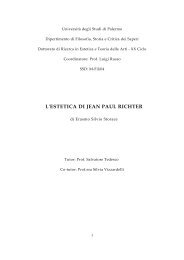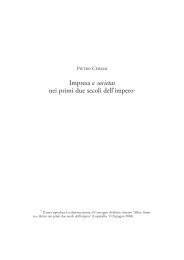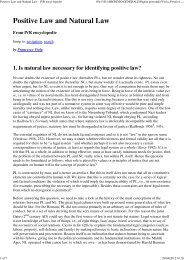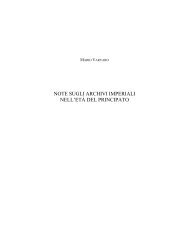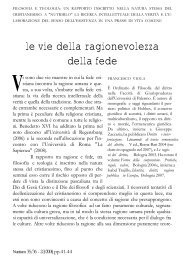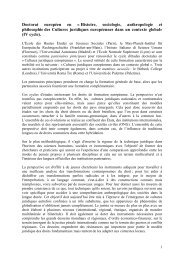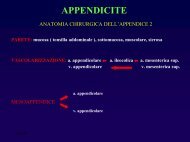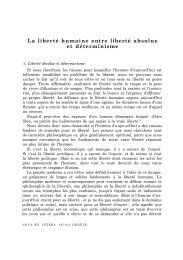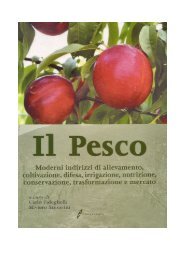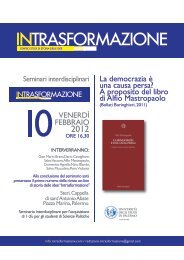M. VARVARO, Gai 4.163 e la struttura della formula arbitraria nell ...
M. VARVARO, Gai 4.163 e la struttura della formula arbitraria nell ...
M. VARVARO, Gai 4.163 e la struttura della formula arbitraria nell ...
Create successful ePaper yourself
Turn your PDF publications into a flip-book with our unique Google optimized e-Paper software.
M. Varvaro, <strong>Gai</strong> <strong>4.163</strong> e <strong>la</strong> <strong>struttura</strong> del<strong>la</strong> formu<strong>la</strong> <strong>arbitraria</strong> [p. 705-734]<br />
zione ‘NEQVE’. 81 In questa direzione, infatti, spinge <strong>la</strong> testimonianza<br />
che riguarda il modo in cui era enunciata <strong>la</strong> c<strong>la</strong>uso<strong>la</strong> restitutoria in<br />
seno al<strong>la</strong> formu<strong>la</strong> dell’actio quod metus causa, che, come <strong>la</strong> formu<strong>la</strong><br />
<strong>arbitraria</strong> del procedimento ex interdicto, era in factum concepta.<br />
7. Sul<strong>la</strong> scorta delle riflessioni sin qui svolte è possibile concludere<br />
suggerendo una nuova ricostruzione del<strong>la</strong> conceptio uerborum di una<br />
formu<strong>la</strong> <strong>arbitraria</strong> in un procedimento sine poena diretto ad accertare<br />
<strong>la</strong> vio<strong>la</strong>zione di un interdetto Quod ui aut c<strong>la</strong>m, nel<strong>la</strong> quale a una<br />
intentio formu<strong>la</strong>ta al ‘SI PARET’ seguono <strong>la</strong> c<strong>la</strong>uso<strong>la</strong> restitutoria introdotta<br />
da ‘NEQVE’ e <strong>la</strong> condemnatio al ‘QVANTI EA RES EST’: 82<br />
Lucius Octauius iudex esto. Si paret in hoc anno, cum experiundi<br />
potestas esset, proihibente (c<strong>la</strong>m ) Aulo Agerio in solo illo opus quo de<br />
agitur a Numerio Negidio factum esse, neque ea res arbitrio iudicis restituetur,<br />
quanti ea res est, tantam pecuniam Lucius Octauius iudex<br />
Numerium Negidium Aulo Agerio condemnato; si non paret, absoluito.<br />
—————————<br />
81 In questo senso v. G. PUGLIESE, Il processo civile romano, II, 1, cit. (nt. 56), 190, nt.<br />
96. Per <strong>la</strong> formu<strong>la</strong>zione introdotta da ‘NEQVE’ propende anche M. KASER, Das römische<br />
Zivilprozessrecht 2 , cit. (nt. 3), 336. Appaiono sprovviste di solidi appigli testuali, infatti,<br />
anche le ricostruzioni con ‘NISI’ proposte dagli studiosi: v., per esempio, A.F. RUDORFF,<br />
De iuris dictione edictum, cit. (nt. 6), 75: actio Publiciana; 76 s.: actio de fundo uectigali id<br />
est emphyteuticario; 78: actio confessoria e prohibitoria ususfructus; 79: actio confessoria<br />
seruitutis; 164: actio aquae pluuiae arcendae; 201: actio Pauliana; G. DEMELIUS, Die<br />
Exhibitionspflicht, cit. (nt. 67), 36: actio ad exhibendum; O. LENEL, EP 3 , cit. (nt. 3), 190:<br />
actio confessoria e actio negatoria ususfructus; 223: actio ad exhibendum; 494 s.: actio<br />
Seruiana.<br />
82 Per le ragioni che inducono a preferire questa formu<strong>la</strong>zione v. supra, § 2, nt. 23.<br />
734 AUPA 55/2012



